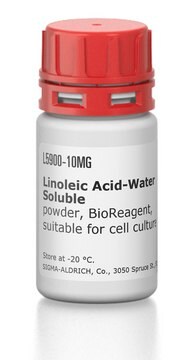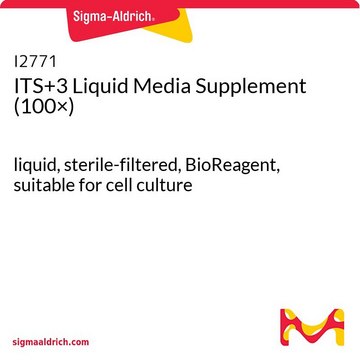L9655
Linoleic Acid-Oleic Acid-Albumin, 100x
liquid, sterile-filtered, BioReagent, suitable for cell culture
Synonym(e):
Fatty Acid-Albumin-complexes
About This Item
Empfohlene Produkte
Biologische Quelle
protein from bovine
Qualitätsniveau
Sterilität
sterile-filtered
Produktlinie
BioReagent
Form
liquid
Zusammensetzung
linoleic acid and oleic acid, 2 mol/mol albumin (each)
Konzentration
100 mg/mL BSA in DPBS
Methode(n)
cell culture | mammalian: suitable
Verunreinigungen
endotoxin, tested
Lagertemp.
2-8°C
Allgemeine Beschreibung
Anwendung
- to induce acute hepatocellular stress in primary hepatocytes
- to induce oxidative stress in cytotrophoblasts
- to induce lipid droplet accumulation in HepG2 cells
Ähnliches Produkt
Lagerklassenschlüssel
10 - Combustible liquids
WGK
WGK 3
Flammpunkt (°F)
Not applicable
Flammpunkt (°C)
Not applicable
Persönliche Schutzausrüstung
Eyeshields, Gloves
Analysenzertifikate (COA)
Suchen Sie nach Analysenzertifikate (COA), indem Sie die Lot-/Chargennummer des Produkts eingeben. Lot- und Chargennummern sind auf dem Produktetikett hinter den Wörtern ‘Lot’ oder ‘Batch’ (Lot oder Charge) zu finden.
Besitzen Sie dieses Produkt bereits?
In der Dokumentenbibliothek finden Sie die Dokumentation zu den Produkten, die Sie kürzlich erworben haben.
Kunden haben sich ebenfalls angesehen
Artikel
Importance and uses of linoleic acid in serum-free eukaryotic, including hybridoma and Chinese Hamster Ovary (CHO) cell, cultures
How the unsaturated fatty acid, oleic acid and other cell culture components affect the performance of serum-free, protein-free cell culture systems used for biomanufacturing heterologous proteins including monoclonal antibodies.
Unser Team von Wissenschaftlern verfügt über Erfahrung in allen Forschungsbereichen einschließlich Life Science, Materialwissenschaften, chemischer Synthese, Chromatographie, Analytik und vielen mehr..
Setzen Sie sich mit dem technischen Dienst in Verbindung.








